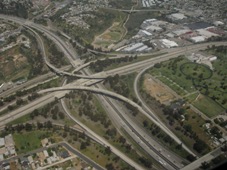Kristine Wong is our Climate Watch intern for the current term. She’s a student at UC Berkeley’s Graduate School of Journalism.
 Study comparing environmental impact of transportation modes yields surprising results
Study comparing environmental impact of transportation modes yields surprising results
By Kristine Wong
You may not believe that during peak commute hours, Boston’s light rail system generates more greenhouse gases (GHGs) per person than a gas-powered, fully occupied SUV–or a commercial airliner filled to capacity, traveling the same distance.
Yet this is what UC Berkeley researchers found in a study released this week. Mikhail Chester and Arpad Horvath compared the environmental impacts of cars, buses, planes, and rail after adding up all the energy costs and emissions (both GHGs and local air pollutants) over their entire life cycle–not just by what came out of the tailpipe. The authors say no such comprehensive study had been done before.
The researchers developed a method that evaluated each transportation mode based on the energy inputs needed for production and maintenance of the vehicle itself. They also looked at the infrastructure for each mode, such as construction of supporting components like rail station platforms and airport runways, bus and rail station lighting and parking, and the source of power for each mode (e.g. gasoline, jet fuel, diesel or electric–and the costs of distributing and producing these inputs).
In total, Chester and Horvath compared 79 components across all transportation modes. Within each they also selected a few variations to represent differences, depending on factors such as vehicle make and mileage, passenger occupancy, and size.
The results were both logical and surprising. Most of the energy consumed and GHG emissions from auto, bus and air travel originated from the operational period, not from the materials needed to produce and maintain the vehicles. Rail produced the greatest amount of GHGs compared to all other modes over their life cycle. But Chester and Horvath point out that there is a big difference in GHG emissions from light rail systems in the Bay Area versus, say, Boston due to the portion of fossil fuel-based electricity used. Boston’s fuel mix is 82% fossil, while the Bay Area’s BART system clocks in at just 49% fossil fuel–a major factor in efficiency and GHG emission rates.
Finally, passenger occupancy was a key factor influencing efficiency. Not surprisingly, each mode was most efficient when used to capacity. But the researchers caution that boosting passenger occupancy is not a magic bullet. They say minimizing fossil fuel inputs and adding pollution filters and controls would have a greater effect on efficiency.
Chester and Horvath say that they hope their results will provide a framework for more comprehensive analysis of the environmental impacts of transportation, and to assess the impact of hybrid or electric vehicles and alternative energy sources such as biofuels, solar power, and wind power, none of which were included in the study.
There are more details of the study posted at the websites for Green Car Congress and Sustainable Transportation.
2 thoughts on “Transportation’s Tricky Carbon Footprint”
Comments are closed.

…Fully loaded SUV.
How are the GPS-enabled rideshare and/or hitchiker-security apps coming along?
(I know there’ve been some, but don’t know their strengths & weaknesses & track records)
I ran into a guy recently who has developed an iPhone app for ride-sharing called: “Carticipate.”
Haven’t tried it, can’t vouch for it but it’s apparently been around for almost a year. There was an early post at the Apple blog that further describes it:
http://theappleblog.com/2008/08/03/find-a-carpool-buddy-with-carticipate/